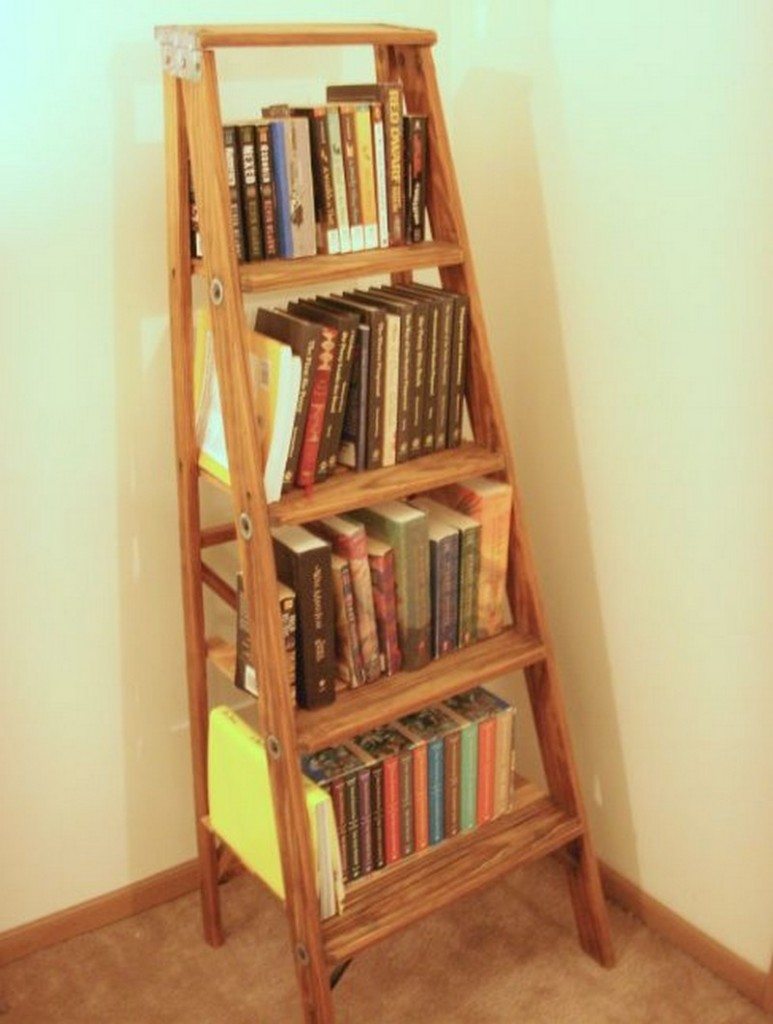Got plenty of books but have a small room? maybe you’d just like to add a unique conversation piece to your study? This DIYer found the perfect solution in the most unexpected place – the trash, a DIY ladder bookshelf!
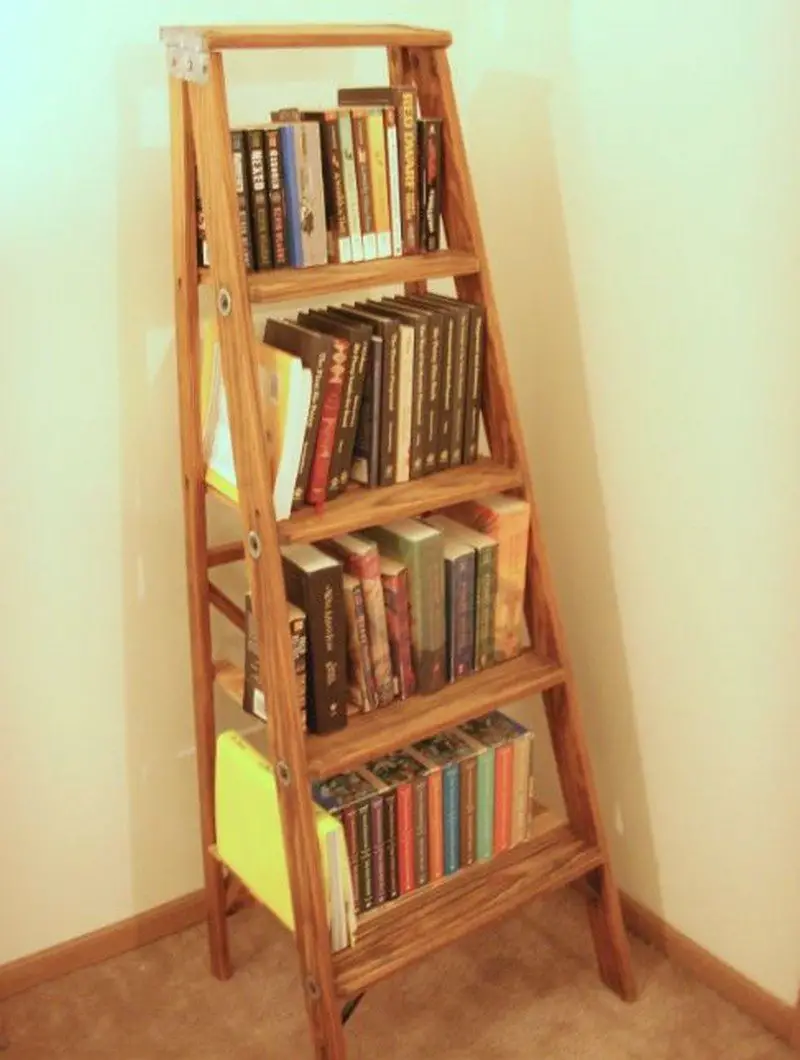
Contents
Key Insights Before Crafting a DIY Ladder Bookshelf
What should be known before building a DIY bookshelf ladder? Here are some key insights before delving into this DIY project.
- Perfect for Beginners
- Crafting your own DIY bookshelf ladder is an ideal entry-level project for those new to woodworking. It’s a manageable endeavor that offers the satisfaction of creating something substantial without overwhelming complexity.
- Simple Construction
- The design is straightforward, requiring limited technical skills. You’ll use basic construction techniques, which means you won’t need to invest in high-end tools or master advanced woodworking skills to get started.
- Minimal Tools Required
- One of the great aspects of this project is that it doesn’t demand a workshop full of tools. Basic equipment like a saw, drill, and sander will suffice. Brands like DeWalt, Black+Decker, or Makita offer affordable, reliable options for these tools.
- Quick Turnaround
- Expect to complete the bookshelf within just a few hours, making it a perfect choice for a weekend project. This timeline means you can start in the morning and have a functional piece by evening without needing extended planning or preparation.
- Preparation and Planning
- Before diving in, ensure you have accurate measurements and a clear plan of the shelf dimensions. It’s crucial to obtain the right materials—typically, a solid wood like pine or oak works well. Be sure to pre-sand your wood for a smooth finish.
- Safety First
- Always prioritize safety when working with tools. Use safety goggles, gloves, and ear protection. A sturdy workspace and good lighting can also prevent mishaps.
- Final Touches
- Consider your shelf’s finish—painting or staining can enhance the wood’s natural beauty. This step allows you to customize the bookshelf to match your decor and bring a personal touch to your finished project.
By keeping these factors in mind, you can embark on your DIY ladder bookshelf adventure with confidence, knowing you’re well-prepared to create a functional and stylish addition to your space.
Building a DIY Ladder Bookshelf for Practical Chic Storage
This dingy old ladder was ready for the dump but was given a new life. With a book collection that needed shelving, and an unwillingness to buy a new bookshelf, this DIYer realized that transforming this ladder into a stylish bookshelf offered the perfect solution.
What’s great about this DIY ladder bookshelf is that it’s light-weight and built in such a way that you could easily disassemble it to relocate. It doesn’t consume a lot of floor space, and provides a surprising amount of storage.
Save space and money by using free, salvaged materials for your DIY ladder bookshelf project. Only brackets and finishing materials need to be purchased.
Materials:
- Ladder
- ¼” Red Oak Planks
- ¼ – ½” Red Oak Support
- ½ x 1 ½” Red Oak
- 1 ½” Shelf Brackets – cross bars support
- Shelf Braces – mending plates, cross bars support
- Wood Glue
- Sandpaper
- Wood Finish
- ½” – 5/8” Wood Screws
Tools:
- Jig Saw
- Sander
- Drill
- Level
- T-Square
- Tape Measure
Step-by-Step Guide:
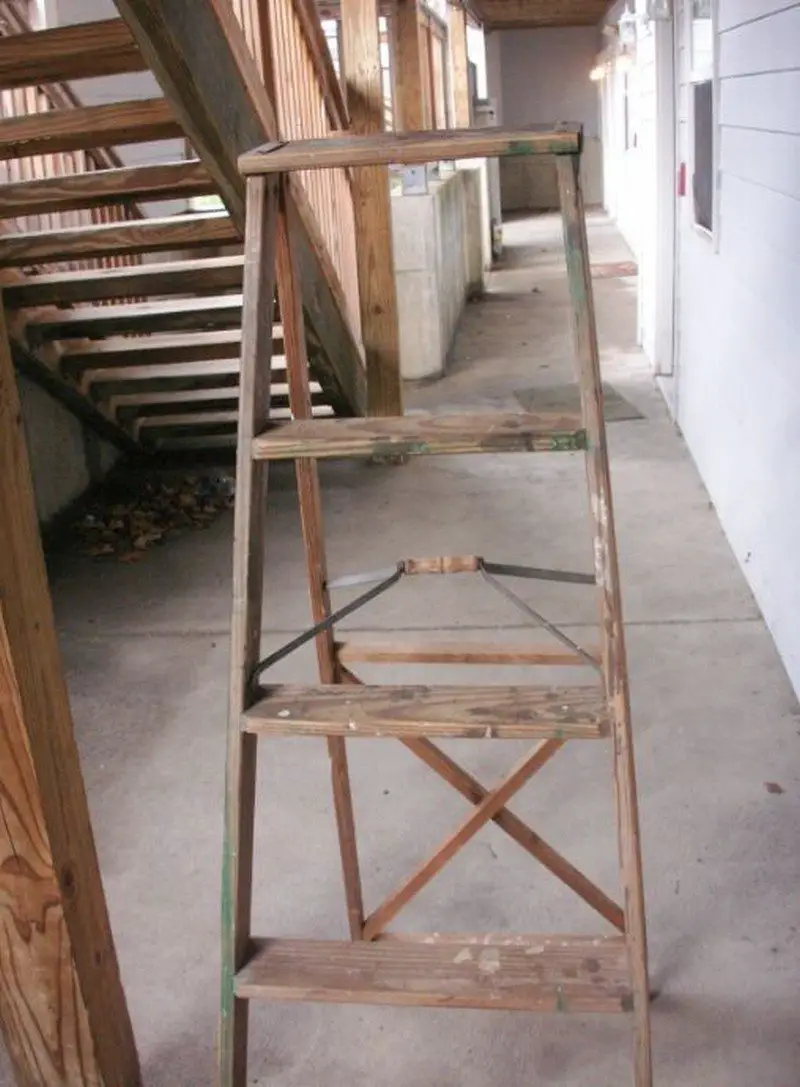
Begin by sanding the entire ladder to strip away the existing paint. Although this can be a lengthy and labor-intensive process, it’s well worth the effort. Sanding will not only reveal the beautiful wood underneath but also create a smooth surface, ready for any new finish or paint.
Take your time with this step to ensure an even, polished result that highlights the ladder’s natural beauty and character.

After sanding, attach metal braces under ladder steps carefully for stability and balance, supporting shelf weight.
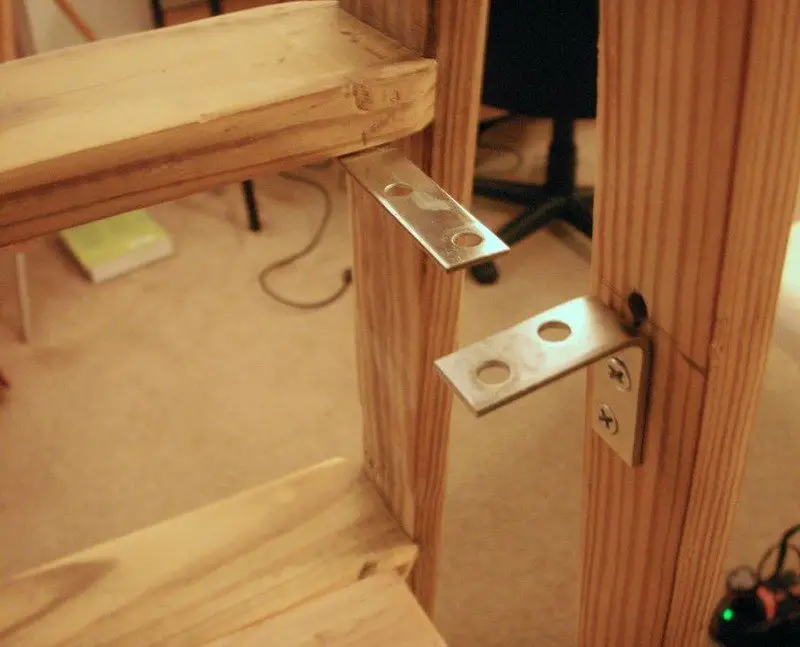
After securing the braces, check their placement by attaching the crossbar, which will add additional stability. Ensure that all screws and bolts are tightened securely. With the braces and crossbar in place, the ladder should now be ready to support the shelving without any wobble or misalignment.
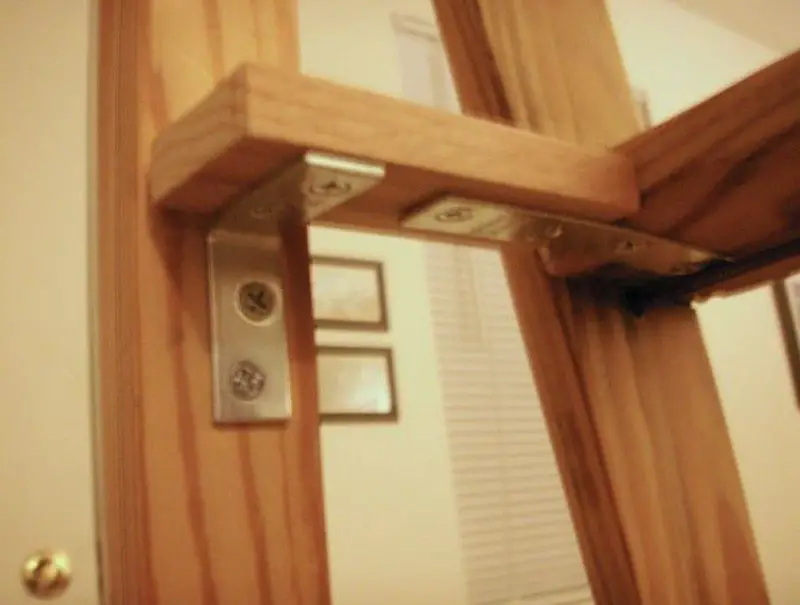
Repeat this process with the remaining ladder steps, using longer crossbars as you move down. These crossbars should sit flush against the back of each step and align with the ladder’s back rail. For accuracy, use a T-Square to ensure precise alignment.
The angle of your cut will vary depending on the angle of the rail next to each crossbar. This step is crucial for a clean, professional finish, so double-check measurements and angles before making any cuts. Proper alignment will ensure that the crossbars fit snugly and securely against the ladder’s structure.
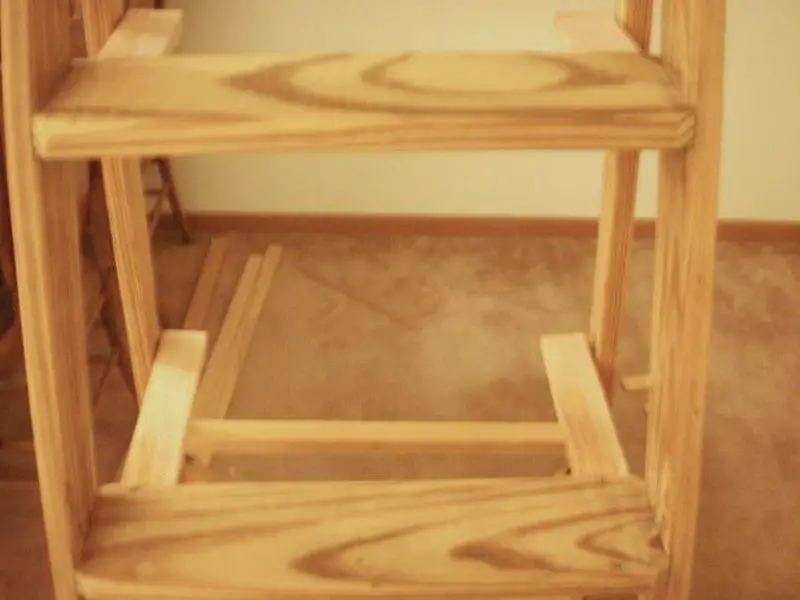
Next, measure and cut the 1/4″ boards to create the shelves, ensuring they fit neatly across each step. To keep the shelves secure, attach small wood supports underneath them; this will prevent any sliding and provide additional weight-bearing capacity for the books you’ll store.
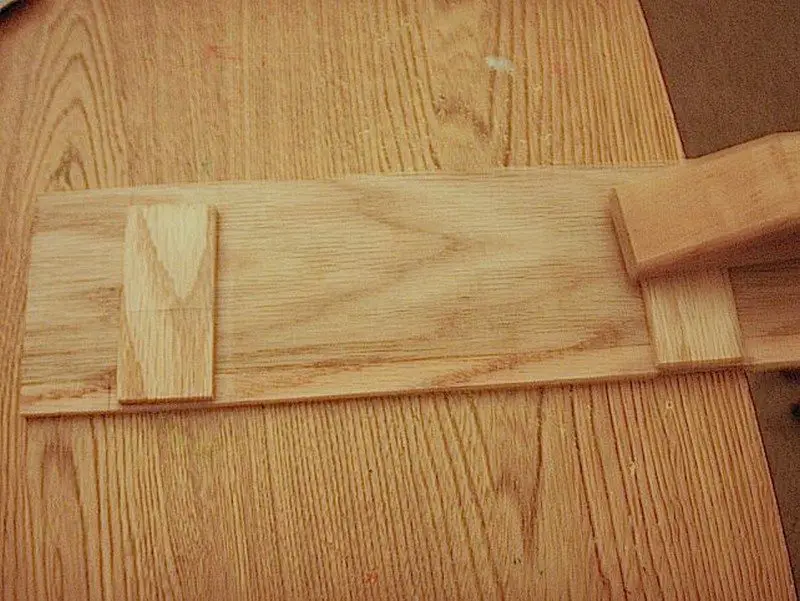
These supports are especially important since the shelves won’t be glued or screwed to the ladder steps. By leaving them unattached, you’ll have the flexibility to disassemble and move the DIY ladder bookshelf easily whenever needed.
This approach allows for simple reassembly while maintaining a sturdy and functional structure.
Now, let’s explore various methods to secure your shelves. Here are a few options:
- Corner Brackets or Figure 8 Brackets
- Attach these to the underside of each shelf for a robust support, ensuring the shelves remain stable.
- Screws
- Consider using screws from the top side for a straightforward installation.
- Dowels or Pocket Holes
- For those with a bit more woodworking experience, dowels or pocket holes can offer a seamless look without visible fasteners.
For a simplified approach, you might opt for wood glue. Apply it to the tops of the ladder steps and clamp the shelves until dry. This method avoids visible nail holes and maintains a clean aesthetic. Glue alone should hold well, but you can also add nails for extra security.

Apply your desired finish to the ladder bookshelf, whether it’s a stain, paint, or clear sealant. This step not only enhances the look of the wood but also protects it from wear and tear. Use a brush or roller to evenly coat all surfaces, paying attention to edges and corners.
Allow the first coat to dry fully, then sand lightly if needed before applying a second coat for a smoother, more polished finish. Once the final coat is dry, your DIY ladder bookshelf will be ready for use, showcasing both style and durability.

Once the finish is completely dry, your ladder bookshelf is ready to be loaded with books! Carefully place your books on each shelf, arranging them in a way that balances the weight evenly across the steps. This will ensure stability and showcase your collection beautifully.
Now, you have a functional and stylish addition to your space, perfect for displaying books and other decorative items. Special thanks to action pig for the great idea!
Advantages of a Freestanding DIY Ladder Bookshelf
When choosing a bookshelf, understanding the differences between freestanding and leaning designs can significantly impact your decision. Here’s why a freestanding DIY ladder bookshelf might be the better option for you:
- Versatility and Mobility
- A Freestanding ladder bookshelf are perfect for individuals who enjoy frequently rearranging their living spaces. Unlike leaning models, these units stand independently without needing to be fixed to a wall, allowing you to easily move them from room to room.
- Ideal for Renters
- If you’re renting and discouraged by the idea of drilling into walls, a freestanding shelf offers the perfect solution. It eliminates the hassle and potential damage deposit issues associated with mounted furniture.
- No Installation Required
- Skip the tools and mounting hardware. With a freestanding design, assembly is often straightforward, making it accessible even for those without a knack for DIY projects.
- Stability and Support
- Without relying on wall support, freestanding shelves offer excellent stability on their own. This feature can be particularly beneficial if your walls are uneven or if you have concerns about weight distribution.
Freestanding DIY ladder bookshelves combine flexibility, ease of use, and aesthetic appeal, making them an excellent choice for many homes.
The Takeaway
Building a DIY ladder bookshelf is a rewarding and creative way to add both function and charm to your space.
With just a few materials and some basic tools, you can transform an old ladder into a unique storage solution that showcases your books and treasures. Not only does this project offer a chance to personalize your home, but it also allows you to upcycle and give new life to something old.
So, gather your supplies, follow these steps, and enjoy the satisfaction of crafting a stylish and practical piece of furniture with your own hands!
Frequnetly Asked Questions
- Are there any tips for installation?
- It’s important to ensure the supports are straight and square to the floor, which can be done by visually checking and making adjustments as needed.
- How is alignment ensured?
- A scrap board and a speed square are used for marking lines, which help in aligning the front supports to match the height of the back ones.
- Where are the supports positioned?
- Supports are placed along both the front and back of the frame, ensuring even distribution to hold the shelves effectively.
- How are the supports attached?
- The supports are attached using pocket holes drilled into the ends, secured with screws and wood glue to ensure stability.
- How can existing materials be utilized?
- You can use plywood or wide board scraps you might have on hand, making it an efficient way to utilize leftover materials.
- What are the size requirements for each shelf?
- The top shelf can use a 1×8 board, the second shelf a 1×10, and the middle a 1×12. The bottom shelves require joining smaller pieces as they aren’t standard sizes.
- How should the shelves be constructed based on material choice?
- If using plywood, you can cut the shelves directly from a sheet, requiring less than half a sheet. For solid wood, you’ll need to glue boards together to form panels, especially for the wider shelves.

